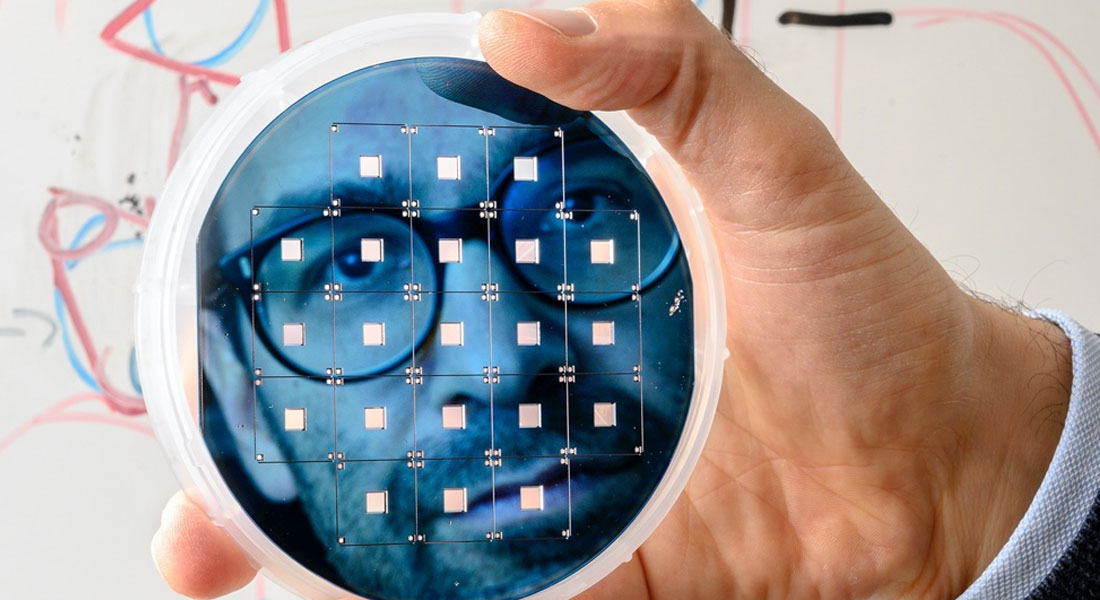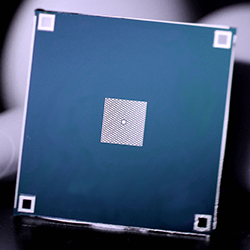ERC grant to develop phononic quantum sensors at the Niels Bohr Institute
The European Research Council (ERC) has awarded a Consolidator Grant to Albert Schliesser, professor at the Niels Bohr Institute (NBI), University of Copenhagen. Professor Schliesser’s group has been known for pioneering studies on measuring and controlling motion with a precision all the way down to the level where the fundamental, and sometimes bizarre laws of quantum mechanics rule. For this purpose, the group has invented thin membranes with a special “phononic” pattern of perforations, whose vibrations can be controlled particularly precisely.

With the support of the ERC, they can now explore the development of such devices into a sensor platform capable of detecting forces with unprecedented precision. Potential impact covers both basic quantum research and applications in technology, and range from fundamental tests of quantum mechanics to novel approaches to nanoscale microscopy. The grant will be running for a period of 5 years.
Superposition: being in two different states at the same time
Professor Albert Schliesser explains: “To put it simply, we have one big, shiny goal. Namely, to measure a force in a quantum superposition. Now, what does that mean?

The membrane contains a pattern of holes, with one small island in the center. A thin silicon nitride membrane (white) is stretched tight across a silicon frame (blue).
To say that something is capable of superposition means that it has the capability of being in two different states at the same time. In the case of the membrane (the picture on the right) - our force sensor, - it means that it can point up and down at the same time. We want to see if our – rather big – force sensor really moves in both directions simultaneously. That is what quantum mechanics predicts". Superposition is normally considered a property of much smaller objects. Electrons, for example, can exert such a force via their property known as spin, essentially the fact that they behave like a small magnet. Only, here we are talking about a quantum magnet, which can be oriented two ways at the same time, an example of a quantum superposition.
The superposition principle is a core tenet of quantum mechanics, meaning that an object can simultaneously occupy two states – even locations – simultaneously. Since quantum mechanics was introduced by Bohr, Heisenberg, and others some 100 years ago, countless experiments have confirmed that microscopic objects, such as electrons or atoms, behave this way. Yet large-scale superpositions have never been observed with massive objects visible to the naked eye. And it is an open question to this day as to exactly why that is. Is it just a matter of technological advances, of measurement sensitivity, or are the some fundamental, yet unknown mechanisms at play that prevent it?
“And this is where the phononic membranes come in”, says Schliesser, “they are uniquely suited for this purpose,” since they can detect the smallest of forces.
A flexible grant to explore many facets of phononic sensors
“The project has a 5 year span, it is flexible and generous. This makes it possible to pursue such an ambitious goal, but also look to the left and right for exciting opportunities along the way”, he explains. And as a second-time grantee (he has received an ERC starting grant in 2015) he has some experience. One already identified spinoff outcome is that the membranes could be used to build a new kind of atomic force microscope (AFM). In an AFM, a small tip scans over the surface of a material. When the tip approaches a surface, the two exert a force on each other. The ensuing changes of the tip vibration indicate varying distance to, and properties of that surface. In this manner, an image of the surface can be built, resolving viruses, molecules or even individual atoms. Some of the most technologically demanding variants of AFM, however, suffer from insufficient force sensitivity. By putting the samples on the membrane, and vibrating the membrane instead of the tip, the sensitivity can be improved. This could allow resolving features otherwise unseen in these variants of AFM. “With collaborators at the ETH Zurich, we have already demonstrated some elements of this approach, by recording images of viruses using the membrane as sensor. This is quite encouraging,” says Schliesser. One goal of this research is to establish new imaging modalities for nanoscience, especially nanobiology.
Even other aspects of the grant pertain to manipulating quantum noise of light, a major limitation in gravitational wave detectors (GWD). The most recent addition to astronomers’ observational possibilities, GWDs detect the movement of huge masses, such as black holes, by measuring how they push and pull test masses on earth. Laserlight is used to measure the movement of the test masses. “The technological sophistication of these instruments is daunting, yet there is always something to improve. The volume of the part of the universe which can be observed grows quickly with even small improvements in sensitivity. Therefore, manipulating quantum noise of light in just the right way is a worthwhile task. Again, this is not the focus of the project, but being able to contribute to this great scientific endeavor of our age would surely be some icing on the cake”, Albert Schliesser explains.
See also:
Contact
Albert Schliesser, Professor
Quantum Optics, Blegdamsvej 17, 2100 København Ø, Building F & T,
Email: albert.schliesser@nbi.ku.dk
